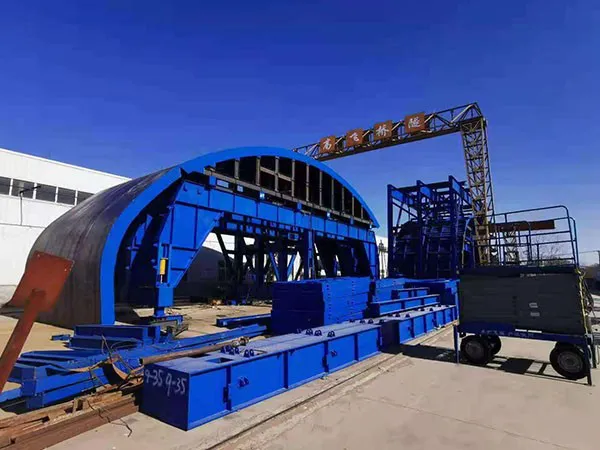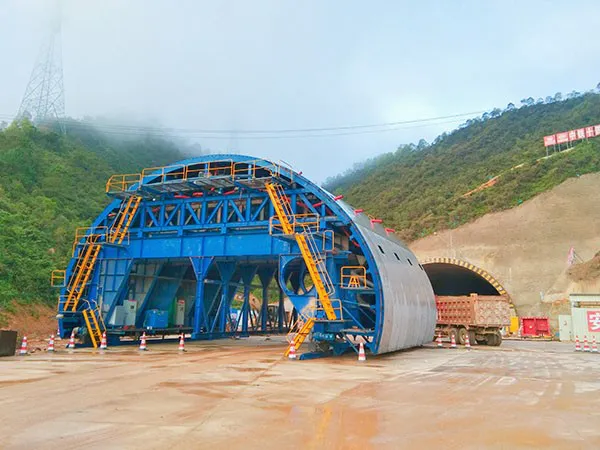This guide provides a comprehensive overview of tunnel lining trolley maintenance practices to maximize lifespan and ensure efficient operation. It covers various aspects of inspection, lubrication, cleaning, repair, and storage, tailored for the harsh tunnel environment.

Tunnel lining trolleys are critical for the safe and efficient construction of tunnel linings. Their robust construction is designed to withstand heavy loads and abrasive conditions, but regular maintenance is crucial to prevent premature failure and costly downtime. This guide is applicable to various types of tunnel lining trolleys, but consult the manufacturer's specific documentation for detailed instructions and recommendations.
Lockout/Tagout: Always follow proper lockout/tagout procedures before performing any maintenance. Isolate the trolley from power sources and ensure it cannot be accidentally started.
Personal Protective Equipment (PPE): Wear appropriate PPE, including hard hat, safety glasses, gloves, and steel-toed boots. Hearing protection may be required depending on the maintenance task.
Confined Space Entry: If working inside enclosed sections of the trolley, follow confined space entry procedures.
Qualified Personnel: Maintenance should be performed by trained and qualified personnel.
Manufacturer's Manual: Always refer to the manufacturer's manual for specific safety guidelines and procedures.
Regular inspections are key to identifying potential problems before they lead to major failures. Frequency should be based on usage and environmental conditions, but daily pre-shift and weekly thorough inspections are recommended.
A. Daily Pre-Shift Inspection:
Visual Inspection:
Overall Condition: Check for obvious damage, cracks, deformation, or excessive wear.
Hydraulic System: Inspect hoses, fittings, cylinders, and pumps for leaks.
Electrical System: Check wiring, connections, and switches for damage or loose connections.
Wheels and Rails: Inspect wheels for damage, wear, and proper alignment. Check rails for debris and obstructions.
Safety Devices: Verify the functionality of emergency stops, alarms, and limit switches.
Formwork: Inspect the formwork for damage, cleanliness, and proper alignment.
Operational Checks:
Movement: Ensure smooth and consistent movement of the trolley.
Hydraulic Functions: Test all hydraulic functions, such as lifting, lowering, and tilting.
Brakes: Verify proper brake function.
Lighting: Check the functionality of all lights.
B. Weekly Thorough Inspection:
All items from Daily Inspection.
Structural Components:
Welds: Inspect welds for cracks, corrosion, or signs of stress.
Bolts and Fasteners: Check for loose or missing bolts and fasteners. Tighten as necessary.
Frame: Inspect the frame for deformation or cracks.
Hydraulic System:
Fluid Level: Check the hydraulic fluid level and top off as needed.
Filters: Inspect and replace hydraulic filters according to the manufacturer's schedule.
Pressure Readings: Check system pressure readings against specifications.
Electrical System:
Wiring Harness: Inspect the entire wiring harness for damage or chafing.
Control Panel: Check the control panel for corrosion or damage.
Grounding: Verify proper grounding of the trolley.
Wheel System:
Wheel Bearings: Check wheel bearings for excessive play or noise.
Tire Pressure (if applicable): Maintain proper tire pressure.
Wheel Alignment: Verify wheel alignment to prevent uneven wear.
Formwork:
Seals: Inspect seals for damage or wear.
Vibrators (if applicable): Check the functionality of vibrators and ensure proper vibration levels.
Formwork Locking Mechanisms: Ensure locking mechanisms are in proper working order.

Proper lubrication is essential for minimizing wear and extending the life of moving parts.
Lubrication Points: Identify all lubrication points on the trolley. These are typically found on:
Wheel Bearings: Use a high-quality grease specifically designed for wheel bearings.
Pivot Points: Lubricate pivot points with a suitable grease or oil.
Hydraulic Cylinder Rods: Apply a thin coat of grease to hydraulic cylinder rods to prevent corrosion.
Rail Wheels: Lubricate the wheel flanges and rail contact areas.
Lubricant Type: Use the lubricant recommended by the manufacturer.
Frequency: Lubricate regularly, based on the manufacturer's recommendations and operating conditions. Heavier use and harsher environments require more frequent lubrication.
Method: Use appropriate lubrication tools, such as grease guns and oil cans.
Record Keeping: Maintain a lubrication schedule and record all lubrication activities.
Tunnel environments are often dirty and dusty. Regular cleaning is essential for preventing the build-up of debris that can damage the trolley.
Frequency: Clean the trolley daily, especially after each use.
Method:
Pressure Washing: Use a pressure washer to remove dirt, dust, and concrete slurry.
Brushing: Use brushes to remove stubborn debris.
Solvent Cleaning: Use appropriate solvents to remove grease and oil. Avoid using harsh solvents that can damage paint or seals.
Areas to Focus On:
Wheels and Rails: Keep wheels and rails clean to ensure smooth movement.
Hydraulic Components: Clean hydraulic components to prevent contamination.
Electrical Connections: Clean electrical connections to prevent corrosion.
Formwork: Keep the formwork clean to ensure a smooth concrete surface.
Prompt Repair: Repair any damage or malfunctions promptly to prevent further problems.
Qualified Technicians: Use qualified technicians for all repairs.
Genuine Parts: Use genuine replacement parts to ensure proper fit and performance.
Hydraulic System Maintenance:
Hose Replacement: Replace hydraulic hoses at regular intervals, as recommended by the manufacturer.
Cylinder Repair: Repair or replace damaged hydraulic cylinders.
Pump Maintenance: Maintain hydraulic pumps according to the manufacturer's recommendations.
Electrical System Maintenance:
Wiring Repair: Repair or replace damaged wiring.
Switch Replacement: Replace faulty switches.
Control Panel Repair: Repair or replace damaged control panel components.
Wheel System Maintenance:
Wheel Replacement: Replace worn or damaged wheels.
Bearing Replacement: Replace worn or damaged bearings.
Alignment Adjustment: Adjust wheel alignment as needed.
Formwork Maintenance:
Seal Replacement: Replace worn or damaged seals.
Vibrator Repair: Repair or replace faulty vibrators.
Formwork Repair: Repair or replace damaged formwork sections.
Welding: Ensure all welding is performed by certified welders.
Proper storage is important for protecting the trolley when it is not in use.
Cleaning: Clean the trolley thoroughly before storing it.
Lubrication: Lubricate all moving parts before storing it.
Protection: Store the trolley in a dry, sheltered location to protect it from the elements.
Covering: Cover the trolley to protect it from dust and debris.
Disablement: If storing for an extended period, disconnect the power source and drain hydraulic fluids to prevent leaks. Consider blocking the wheels to prevent movement.
Maintain detailed records of all inspections, lubrication, cleaning, repairs, and maintenance activities. This information will help to:
Track the Trolley's Condition: Monitor the overall condition of the trolley and identify potential problems early on.
Schedule Maintenance: Plan and schedule maintenance activities based on historical data.
Justify Repairs: Provide documentation to justify the need for repairs.
Maximize Lifespan: Optimize maintenance practices to maximize the lifespan of the trolley.
Warranty Claims: Maintain records for warranty claims if necessary.

Corrosion Prevention: Use corrosion-resistant materials and coatings to protect the trolley from the corrosive environment. Regularly apply anti-corrosion treatments to exposed metal surfaces.
Dust Control: Implement dust control measures to minimize the amount of dust and debris that accumulates on the trolley.
Waterproofing: Ensure that electrical components are properly waterproofed to prevent damage from moisture.
Vibration Resistance: Use vibration-resistant components and mountings to withstand the vibrations generated during tunnel construction.
Operator Training: Provide thorough training to operators on the proper operation and maintenance of the trolley.
By following this comprehensive maintenance guide, tunnel lining trolley operators can significantly extend the life of their equipment, reduce downtime, and improve the overall efficiency and safety of tunnel construction projects. Remember to consult the manufacturer's specific recommendations for your trolley model. Regular, proactive maintenance is the key to ensuring the long-term reliability and performance of this essential piece of equipment.
Gaofei
Address: 200m east of tulip garden, group 12 of zhangling community, hongshan street office, hongshan town, xigong district, Luoyang
Tel: +8616638856888
Contact: Gaofei Huang
Mobile: +86-18637923976
Phone: 0379-80881719/ 0379-60162687
QQ: 286827457
E-mail: gaofei@gf-bridge-tunnel.com